#original 20th century pieces
Text
Website : https://www.midmod.pt/
Address : Rua São João Nepomuceno 32B, Lisboa, Portugal 1250-233
Mid Mod, established in 2017 in Lisbon's Lapa neighborhood, specializes in Mid Century Modern pieces from the 50s, 60s, and 70s. Curated by Henrique Salgado, the store offers an eclectic collection of original pieces by acclaimed designers. Known for its unique blend of elegant design and vibrant colors, Mid Mod ensures each item's authenticity and origin. The store extends its expertise through various bespoke services, including interior and lighting consultancy, plant consultancy, home and event staging, rental, and restoration. Embracing the art-design connection, Mid Mod collaborates with contemporary artists and showcases international works. Customers can visit the showroom by appointment or explore the collection online, with international shipping available.
Facebook : https://www.facebook.com/midmodlx/
Keywords:
Vintage furniture
Vintage furniture Lisbon
Lighting design services
Contemporary Portuguese artists
Interior design near me
Mid-century modern design
Portuguese contemporary artists
Restoration services near me
mid century modern design
original 20th century pieces
eclectic showroom collection
interior design consultancy
plant consultancy for homes
event staging and home decor
furniture rental services
restoration of vintage items
unique mid century designs
internationally acclaimed designers
vibrant mid century aesthetics
authentic vintage furniture
curated furniture collection
collaborative art and design
international artist collaborations
sustainable furniture choices
eco conscious vintage living
mid century modern authenticity
home decor with historical value
artistic furniture design
bespoke home furnishing services
vintage design showroom lisbon
exclusive mid century furnishings
authentic designer furniture
vintage art and design fusion
creative interior design solutions
unique vintage home accessories
stylish furniture for homes
mid century inspired decor
classic 20th century pieces
modern lighting design
plant styling for homes
event decor and staging
furniture leasing services
vintage item restoration
trendsetting mid century designs
designers with international acclaim
timeless mid century aesthetics
vintage authenticity in decor
curated art and design
sustainable and chic furniture
eco friendly vintage living
authentic mid century appeal
historic value in home decor
artistic and functional furniture
custom vintage home accessories
lisbon mid century modern design
original 20th century pieces lisbon
eclectic showroom lisbon
interior design consultancy in lisbon
lighting design lisbon
plant consultancy lisbon
event staging lisbon
home decor in lisbon
furniture rental lisbon
restoration services lisbon
mid century designs lisbon
lisbon acclaimed designers
lisbon mid century aesthetics
vintage furniture in lisbon
curated collection lisbon
art and design lisbon
contemporary artists portugal
international artist collaborations lisbon
sustainable furniture lisbon
eco conscious living lisbon
lisbon mid century authenticity
historical value decor lisbon
artistic furniture lisbon
bespoke home furnishing lisbon
vintage showroom lisbon
exclusive furnishings lisbon
authentic designer lisbon
vintage art fusion lisbon
creative interior design lisbon
vintage furniture near me
mid century modern near me
original 20th century near me
eclectic showroom near me
lighting design near me
plant consultancy near me
event staging near me
home decor near me
furniture rental near me
mid century designs near me
acclaimed designers near me
mid century aesthetics near me
vintage furniture nearby
curated collection nearby
art and design nearby
contemporary artists nearby
international artist collaborations nearby
sustainable furniture near me
#Vintage furniture Lisbon#Lighting design services#Contemporary Portuguese artists#Interior design near me#Mid-century modern design#Portuguese contemporary artists#Restoration services near me#mid century modern design#original 20th century pieces#eclectic showroom collection#interior design consultancy#plant consultancy for homes#event staging and home decor#furniture rental services#restoration of vintage items#unique mid century designs#internationally acclaimed designers#vibrant mid century aesthetics#authentic vintage furniture#curated furniture collection#collaborative art and design#international artist collaborations#sustainable furniture choices#eco conscious vintage living#mid century modern authenticity#home decor with historical value#artistic furniture design#bespoke home furnishing services#vintage design showroom lisbon#exclusive mid century furnishings
1 note
·
View note
Text

New 20th Century Girl
#raisondetrecomic#original character#remake of older piece#retro fashion#the title in both this and the OG pic are a ref to a pizzicato five song#except the og pic was just called '20th century girl'#this one gets the 'new' addition because well...it's new!
12 notes
·
View notes
Text

[be buried]
My heart is a coal that burns on the banks of Ithaca,
The blackening wake, the pale rind of the sea.
It laps at my liver, a bloom on the bluffs of the Caucasus,
My blood runs down the wet rocks
Like tongues of heroin or black tea--
Laced like Dionysus, leaving slices in the thighs
Tear into me.
Unknown,
Beneath the skin,
Between the bones,
Demons churn like skipping stones,
And leave me limp,
Alone.
Burn me in your pyre,
Rock me on your raft to sleep.
Each rib is a twig to feed the fire,
Or a word to keep.
Come undone, those misfit braids.
Be buried.
Be not afraid.
Breaking in the chest, the flow
Wet and waking, each tide shaking red
And warm and low,
If a heart should find a home,
And rest beneath the skin,
Between the bones.
the lovers ii by rene magritte (1928)
#kind of a companion piece to [fuguestate]#thanks for reading#original poetry#poetry#rene magritte#20th century art#this is what happens when you enter *the apotheosis* at 3am#bad things
3 notes
·
View notes
Text
Ref sheet for Detective Anil, the protagonist of my wattpad story: 'Downpour Alley'. (* ´ ▽ ` *)ノ

I think I might make ref sheets for more characters in the story, but it does take a bit of time and I have a tight schedual on school days so I'd only be able to work more on them on the weekend + probs x-mas half term 🪱👍
Here's the link to my user, I will probably improve the story bc, to be completely honest, I think I've accidently made the chapters too short hehe lol TT
#art#ref sheet#character sheet#original characters#my oc art#my oc#my ocs#my ocs are my children#digital art#artwork#art piece#thriller#mistery#au#alternate universe#horror#20th century#alternate history#sci fi#gothic#goth#cryptic#cryptozoology#cryptidcore#wattpad#novel#story#writing#writer#author
3 notes
·
View notes
Text
category 5 "realized my set class analysis is wrong and now i can't make this post-tonal variation say something noteworthy relative to the theme" event
#teaposts#not fandom#for the super-not-musical folks in the crowd: AAAAAAAAAAA#for the moderately musical folks in the crowd: the piece i'm analyzing includes a theme and variations#and in classical music that usually means the basic tune stays the same in the variations but the rhythm or harmony changes#think 'twinkle twinkle little star' vs 'the (english) alphabet song' (the tune is by mozart originally!)#however comma. composers did a lot of crazy shit in the 20th century. which is when my piece is from#so the relationship between theme and variation is not so simple here. the variations have very little to do with rhythm and harmony#and even (at face value) very little to do with the actual theme you hear#i've come up with other reasons that the previous variations are in fact related to the theme#my original reason for the variation i'm talking about now was that it uses almost the same notes as the theme but in a different structure#but apparently i analyzed it wrong and the notes in this variation actually aren't as similar to the theme's as i thought#and i'm having a hard time getting it to come back together again#so. um. AAAAAAA
6 notes
·
View notes
Note
Do you happen to know the origin of the fantasy trope in which a deity's power directly corresponds to the number of their believers / the strength of their believers' faith?
I only know it from places like Discworld and DnD that I'm fairly confident are referencing some earlier source, but outside of Tinkerbell in Peter Pan, I can't think of of any specific work it might've come from, 20th-c fantasy really not being my wheelhouse.
Thank you!
That's an interesting question. In terms of immediate sources, I suspect, but cannot prove, that the trope's early appearances in both Dungeons & Dragons and Discworld are most immediately influenced by the oeuvre of Harlan Ellison – his best-known work on the topic, the short story collection Deathbird Stories, was published in 1975, which places it very slightly into the post-D&D era, though most of the stories it contains were published individually earlier – but Ellison certainly isn't the trope's originator. L Sprague de Camp and Fritz Leiber also play with the idea in various forms, as does Roger Zelazny, though only Zelazny's earliest work is properly pre-D&D.
Hm. Off the top of my head, the earliest piece of fantasy fiction I can think of that makes substantial use of the trope in its recognisably modern form is A E van Vogt's The Book of Ptath; it was first serialised in 1943, though no collected edition was published until 1947. I'm confident that someone who's more versed in early 20th Century speculative fiction than I am could push it back even earlier, though. Maybe one of this blog's better-read followers will chime in!
(Non-experts are welcome to offer examples as well, of course, but please double-check the publication date and make sure the work you have in mind was actually published prior to 1974.)
#gaming#tabletop roleplaying#tabletop rpgs#dungeons & dragons#d&d#tropes#media#literature#religion#death mention
4K notes
·
View notes
Text
The truth about Medusa and her rape... Mythology breakdown time!
With the recent release of the Percy Jackson television series, Tumblr is bursting with mythological posts, and the apparition of Medusa the Gorgon has been the object of numerous talks throughout this website… Including more and more spreading of misinformation, and more debates about what is the “true” version of Medusa’s backstory.
Already let us make that clear: the idea that Medusa was actually “blessed” or “gifted” by Athena her petrifying gaze/snake-hair curse is to my knowledge not at all part of the Antique world. I still do not know exactly where this comes from, but I am aware of no Greek or Roman texts that talked about this – so it seems definitively a modern invention. After all, the figure of Medusa and her entire myth has been taken part, reinterpreted and modified by numerous modern women, feminist activist, feminist movements or artists engaged in the topic of women’s life and social conditions – most notably Medusa becoming the “symbol of raped women’ wrath and fury”. It is an interesting reading and a fascinating update of the ancient texts, and it is a worthy take on its own time and context – but today we are not talking about the posterity, reinvention and continuity of Medusa as a myth and a symbol. I want to clarify some points about the ACTUAL myth or legend of Medusa – the original tale, as told by the Greeks and then by the Romans.
Most specifically the question: Was Medusa raped?
Step 1: Yes, but no.
The backstory of Medusa you will find very often today, ranging from mythology manuals (vulgarization manuals of course) to Youtube videos, goes as such: Medusa was a priestess of Athena who got raped by Poseidon while in Athena’s temple, and as a result of this, Athena punished Medusa by turning her into the monstrous Gorgon.
Some will go even further claiming Athena’s “curse” wasn’t a punishment but a “gift” or blessing – and again, I don’t know where this comes from and nobody seems to be able to give me any reliable source for that, so… Let’s put this out of there.
Now this backstory – famous and popular enough to get into Riodan’s book series for example – is partially true. There are some elements here very wrong – and by wrong I do mean wrong.
The story of Medusa being raped and turned into a monster due to being raped does indeed exist, and it is the most famous and widespread of all the Medusa stories, the one people remembered for the longest time and wrote and illustrated the most about. Hence why Medusa became in the 20th century this very important cultural symbol tied to rape and the abuse of women and victim-blaming. HOWEVER – the origin of this story is Ovid’s Metamorphoses, from the first century CE or so. Ovid? A Roman poet writing for Roman people. “Metamorphoses”? One of the two fundamental works of Roman literature and one of the two main texts of Roman mythology, alongside Virgil’s Aeneid. This is a purely Roman story belonging to the Roman culture – and not the Greek one. The story of Medusa’s rape does not have Greek precedents to my knowledge, Ovid introduced the element of rape – which is no surprise given Ovid turned half of the romances of Greek mythology into rapes. Note that, on top of all this, Ovid wasn’t even writing for religious purposes, nor was his text an actual mythological effort – he wrote it with pure literary intentions at heart. It is just a piece of poetry and literature taking inspiration from the legends of the Greek world, not some sort of sacred text.
Second big point: The legend I summarized above? It isn’t even the story Ovid wrote, since there are a lot of elements that do not come from Ovid’s retelling of the story (book fourth of the Metamorphoses). For example Ovid never said Medusa was a priestess of Athena – all he said was that she was raped in the temple of Athena. I shouldn’t even be writing Athena since again, this is a Roman text: we are speaking of Minerva here, and of Neptune, not of Athena or Poseidon. Similarly, Minerva’s curse did not involve the petrifying gaze – rather all Ovid wrote about was that Minerva turned Medusa’s hair into snakes, to “punish” her because her hair were very beautiful, and it was what made her have many suitors (none of which she wanted to marry apparently), and it is also implied it is what made Neptune fall in love (or rather fall in lust) with her. I guess it is from this detail that the reading of “Athena’s curse was a gift” comes from – even though this story also clearly does victim-blaming of rape here.
But what is very fascinating is that… we are not definitively sure Neptune raped Medusa in Ovid’s retelling. For sure, the terms used by Ovid in his fourth book of Metamorphoses are clear: this was an action of violating, sexually assaulting, of soiling and corrupting, we are talking about rape. But Ovid refers several other times to Medusa in his other books, sometimes adding details the fourth-book stories does not have (the sixth book for examples evokes how Neptune turned into a bird to seduce Medusa, which is completely absent from the fourth book’s retelling of Medusa’ curse). And in all those other mentions, the terms to designate the relationship between Medusa and Neptune are more ambiguous, evoking seduction and romance rather than physical or sexual assault. (It does not help that Ovid has an habit of constantly confusing consensual and non-consensual sex in his poems, meaning that a rape in one book can turn into a romance in another, or reversal)
But the latter fact makes more sense when you recall that the rape element was invented and added by Ovid. Before, yes Poseidon and Medusa loved each other, but it was a pure romance, or at least a consensual one-night. Heck, if we go back to the oldest records of the love between Poseidon and Medusa, back in Hesiod’s Theogony, we have descriptions of the two of them laying together in a beautiful, flowery meadow – a stereotypical scene of pastoral romances – with no mention of any brutality or violence of any sort. As a result, it makes sense the original “romantic” story would still “leak” or cast a shadow over Ovid’s reinvented and slightly-confused tale.
Step 2: So… no rape?
Well, if we go by Greek texts, no, apparently Medusa was not raped in Greek mythology, and only became a rape victim through Ovid.
The Ancient Greek texts all record Poseidon and Medusa sleeping with each other and having children, but no mention of rape. And the whole “curse of Athena” thing is not present in the oldest records – no temple of Athena soiling, no angry Athena cursing a poor girl… “No curse?” you say “But then how did Medusa got turned into a Gorgon”? Answer: she did not. She was born like that.
As I said before, the oldest record of Medusa’s romance but also of her family comes from Hesiod’s Theogony (Hesiod being one of the two “founding authors” of Greek mythology, alongside Homer – Homer did wrote several times about Medusa, but only as a disembodied head and as a monster already dead, so we don’t have any information about her life). And what do we learn? That Medusa is part of a set of three sisters known as the Gorgons – because oh yes, Ovid did not mention Medusa’s sister now did he? How did Medusa’s sisters ALSO got snake-hair or petrifying-gaze if only Medusa was cursed for sleeping with Neptune? Ovid does not give us any answer because again, it is an “adaptational plot hole”, and the people that try to adapt Ovid’s story have to deal with the slight problem of Stheno and Euryale needing to share their sister’s curse despite seemingly not being involved in the whole Neptune business. Anyway, back to the Greek text.
So, you have those three Gorgon sisters, and Medusa is said to be mortal while her sisters are not. Why is it such a big deal? Because Medusa wasn’t originally some random human or priestess. Oh no! Who were the Gorgons’ parents? Phorcys and Keto/Ceto, aka two sea-gods. Not just two sea-gods – two sea-gods of the ancient, primordial generation of sea-gods, the one that predated Poseidon, and that were cousins to the Titans, the sea-gods born of Gaia mating with Pontos.
So the Gorgons were “divine” of nature – and this is why Medusa being a mortal was considered to be a MASSIVE problem and handicap for her, an abnormal thing for the daughter of two deities. But let’s dig a bit further… Who were Phorcys and Ceto? Long story short: in Greek mythology, they were considered to be sea-equivalents of Typhon and Gaia. They were the parents of many monsters and many sea-horrors: Keto/Ceto herself had her name attributed and equated with any very large creature (like whales) or any terrifying monster (like dragons) from the sea. The Gorgons themselves was a trio of monsters, but their sisters, that directly act as their double in the myth of Perseus? The Graiai – the monstrous trio of old women sharing one eye and one tooth. Hesiod also drops the fact that Ladon (the dragon that guarded the golden apples of the Hesperids), and Echidna (the snake-woman that mated with Typhon and became known as the “mother of monsters”) were also children of Phorcys and Ceto, while other authors will add other monster-related characters such as Scylla (of Charybdis and Scylla fame), the sirens, or Thoosa (the mother of Polyphemus the cyclop). Medusa herself is technically a “mother of monsters” since she birthed both Pegasus the flying horse and Chrysaor, a giant. So here is something very important to get: Medusa, and the Gorgons, were part of a family of monsters. Couple that with the absence of any mention of curses in these ancient texts, and everything is clear.
Originally Medusa was not a woman cursed to become a monster: she was born a monster, part of a group of monster siblings, birthed by monster-creating deities, and she belonged to the world of the “primordial abominations from the sea”, and the pre-Olympian threats, the remnants of the primordial chaos. It is no surprise that the Gorgons were said to live at the edge of the very known world, in the last patch of land before the end of the universe – in the most inhuman, primitive and liminal area possible. They were full-on monsters!
Now you might ask why Poseidon would sleep with a horrible monster, especially when you recall that the Greeks loved to depict the Gorgons as truly bizarre and grotesque. It wasn’t just snake-hair and petrifying gaze: they had boar tusks, and metallic claws, and bloated eyes, and a long tongue that constantly hanged down their bearded chin, and very large heads – some very old depictions even show her with a female centaur body! In fact, the ancient texts imply that it wasn’t so much the Gorgon’s gaze or eyes that had the power to turn people into stone – but that rather the Gorgon was just so hideous and so terrifying to look at people froze in terror – and then literally turned into stone out of fear and disgust. We are talking Lovecraftian level of eldritch horror here. So why would Poseidon, an Olympian god, sleep with one of these horrors? Well… If you know your Poseidon it wouldn’t surprise you too much because Poseidon had a thing for monsters. As a sort of “dark double” of Zeus, whereas Zeus fell in love with beautiful princesses and noble queens and birthed great gods and brave heroes, Poseidon was more about getting freaky with all sorts of unusual and bizarre goddesses, and giving birth to bandits and monsters. A good chunk of the villains of Greek mythology were born out of Poseidon’s loins: Polyphemus, Antaios, Orion, Charybdis, the Aloads… And even his most benevolent offspring has freaky stuff about it – Proteus the shapeshifter or Triton half-man half-fish… So yes, Poseidon sleeping with an abominable Gorgon is not so much out of character.
Step 3: The missing link
Now that we established what Medusa started out as, and what she ended up as… We need to evoke the evolution from point Hesiod to point Ovid, because while people summarized the Medusa debate as “Sea-born monster VS raped and punished woman”, there is a third element needed to understand this whole situation…
Yes Ovid did invent the rape. But he did not invent the idea that Medusa had been cursed by Athena.
The “gorgoneion” – the visual and artistic motif of the Gorgon’s head – was, as I said, a grotesque and monstrous face used to invoke fright into the enemies or to repel any vile influence or wicked spirit by the principle of “What’s the best way to repel bad stuff? Badder stuff”. Your Gorgon was your gargoyle, with all the hideous traits I described before – represented in front (unlike all the other side-portraits of gods and heroes), with the face being very large and flat, a big tongue out of a tusked-mouth, snake-hair, bulging crazy eyes, sometimes a beard or scales… Pure monster. But then… from the fifth century BCE to the second century BCE we see a slow evolution of the “gorgoneion” in art. Slowly the grotesque elements disappear, and the Gorgon’s face becomes… a regular, human face. Even more: it even becomes a pretty woman’s face! But with snakes instead of hair. As such, the idea that Medusa was a gorgeous woman who just had snakes and cursed-eyes DOES come from Ancient Greece – and existed well before Ovid wrote his rape story.
But what was the reason behind this change?
Well, we have to look at the Roman era again. Ovid’s tale of Medusa being cursed for her rape at the hands of Neptune had to rival with another record collected by a Greek author Apollodorus, or Pseudo-Apollodorus, in his Bibliotheca. In this collection of Greek myths, Apollodorus writes that indeed, Medusa was cursed by Athena to have her beautiful hair that seduced everybody be turned into snakes… But it wasn’t because of any rape or forbidden romance, no. It was just because Medusa was a very vain woman who liked to brag about her beauty and hair – and had the foolish idea of saying her hair looked better than Athena’s. (If you recall tales such as Arachne’s or the Judgement of Paris, you will know that despite Athena being wise and clever, one of her main flaws is her vanity).
“Wait a minute,” you are going to tell me, “The Bibliotheca was created in the second century CE! Well after Greece became part of the Roman Empire, and after Ovid’s Metamorphoses became a huge success! It isn’t a true Greek myth, it is just Ovid’s tale being projected here…” And people did agree for a time… Until it was discovered, in the scholias placed around the texts of Apollonios of Rhodes, that an author of the fifth century BCE named Pherecyde HAD recorded in his time a version of Medusa’s legend where she had been cursed into becoming an ugly monster as punishment for her vanity. We apparently do not have the original text of Pherecyde, but the many scholias referring to this lost piece are very clear about this. This means that the story that Apollodorus recorded isn’t a “novelty”, but rather the latest record of an older tradition going back to the fifth century BCE… THE SAME CENTURY THAT THE GORGONEION STARTED LOSING THEIR GROTESQUE, and that the face of Medusa started becoming more human in art.
[EDIT: I also forgot to add that this evolution of Medusa is also proved by strange literary elements, such as Pindar's mention in a poem of his (around 490 BCE) of "fair-cheeked Medusa". A description which seems strange given how Medusa used to be depicted as the epitome of ugliness... But that makes sense if the "cursed beauty" version of the myth had been going around at the time!]
And thus it is all connected and explained. Ovid did invent the rape yes – but he did not invent the idea of Athena cursing Medusa. It pre-existed as the most “recent” and dominating legend in Ancient Greece, having overshadowed by Ovid’s time the oldest Hesiodic records of Medusa being born a monster. So what Ovid did wasn’t completely create a new story out of nowhere, but twist the Greek traditions of Athena cursing Medusa and Medusa having a relationship with Poseidon, so that the two legends would form one and same story. And this explains in retrospect why Ovid focuses so much on describing Medusa’s beautiful hair, and why Ovid’s Minerva would think turning her hair into snake would be a “punishment fit for the crime”: these are leftovers of the Greek tale where Medusa was punished for her boasting and her vanity.
CONCLUSION
Here is the simplified chronology of how Medusa’s evolution went.
A) Primitive Greek myths, Hesiodic tradition: Born a monster out of a family of sea-monsters and monstrous immortals. Is a grotesque, gargoylesque, eldritch abomination. Athena has only an indirect conflict with her, due to being Perseus’ “fairy godmother”. Has a lovely romance with Poseidon.
B) Slow evolution throughout Classical Greece and further: Medusa becomes a beautiful, human-looking girl that was cursed to have snake for hair and petrifying eyes, instead of being a Lovecraftian horror people could not gaze upon. Her conflict with Athena becomes direct, as it is Athena that cursed her due to being offended by her vain boasting. Her punishment is for her vanity and arrogant comparison to the goddess.
C) Ovid comes in: Medusa’s romance with Poseidon becomes a rape, and she is now punished for having been raped inside Athena’s temple.
[As a final note, I want to insist upon the fact that the story of Medusa being raped is not less "worthy" than any other version of the myth. Due to its enormous popularity, how it shaped the figure of Medusa throughout the centuries, and how it still survives today and echoes current-day problems, to try to deny the valid place of this story in the world of myths and legends would be foolish. HOWEVER it is important to place back things in their context, to recognize that it is not the ONLY tale of Medusa, that it was NOT part of Greek mythology, but rather of Roman legends - and let us all always remember this time Poseidon slept with a Lovecraftian horror because my guy is kinky.]
EDIT:
For illustration, I will place here visuals showing how the Ancient art evolved alongside Medusa's story.
Before the 5th century BCE: Medusa is a full-on monster



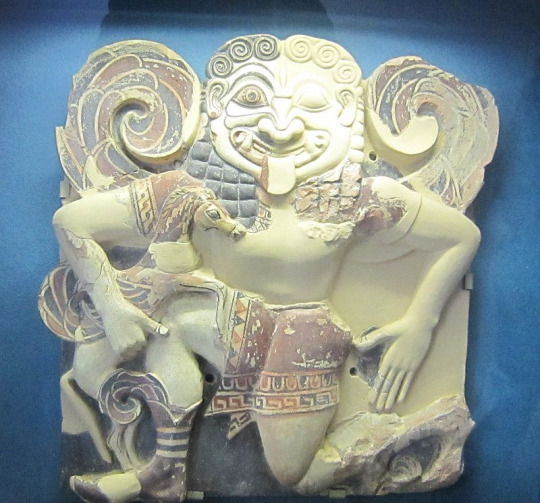

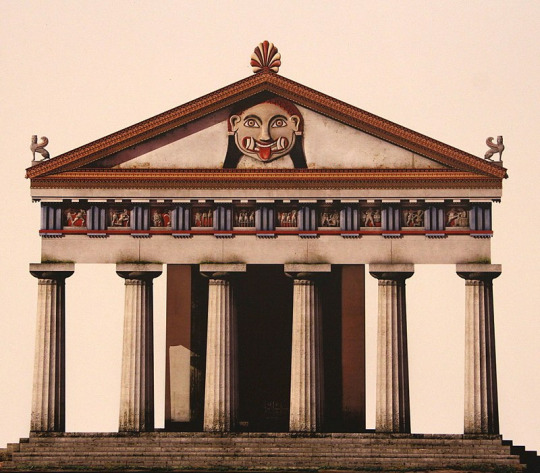
From the 5th century to the 2nd century BCE: A slow evolution as Medusa goes from a full-on monster to a human turned into a monster. As a result the two depictions of the grotesque and beautiful gorgoneion coexist.
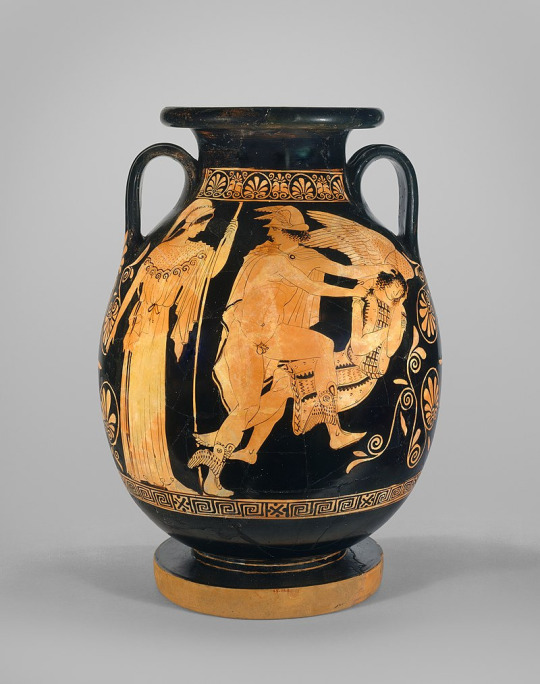


Post 2nd century BCE: Medusa is now a human with snake hair, and just that


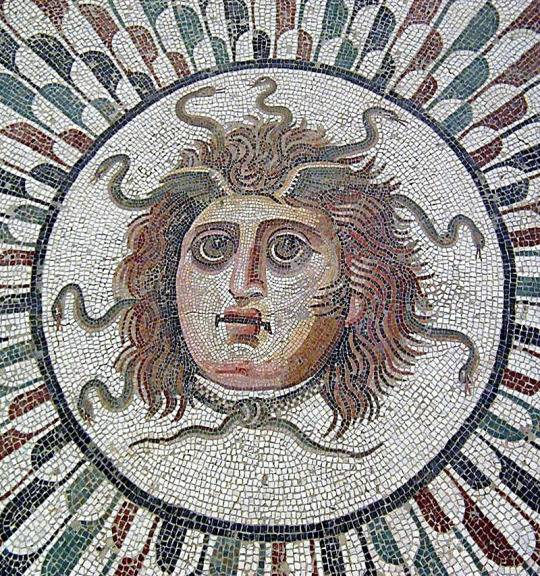
#greek mythology#medusa#gorgon#athena#gorgons#poseidon#neptune#minerva#ovid#rape in mythology#greek monsters#roman mythology
4K notes
·
View notes
Text
I don't know if you're ready for this BUT American Duchess and the Bata Shoe Museum just launched a collab collection called In Bloom.
They made 3 styles in several colours using 3 styles from the the 18th, 19th and 20th centuries from their current exhibition "In Bloom: Flowers and Footwear", and are currently in pre-sale, with estimated deliveries between July and August 2023.
Let's take a look:
We start at the 18th century with the Primrose shoes, based on their Dunmore model, accurate for 1770s-1790s they are embroidered on satin and are $179 USD while in pre-sale and later will be $199. The original style is in black and pink silk satin, and OF COURSE that's my favourite variation, but the green ones are a close second.



Images from top: 1780s shoes, Bata Shoe Museum / Primrose shoes, American Duchess.
From the 19th century we have this style called Flora, accurate for the late 19th century (1870s-1900), are $230 USD while in pre-sale and later will bee $250. This embroidered boots with satin ribbon laces are probably my favourite style from the collection. Of course my fave colour is black, which is also the colour of the original piece, but the lavender ones are just *chef kiss*:
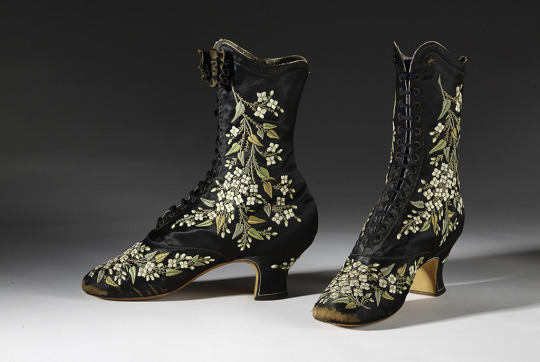


Images from top: the original French embroidered boots by Francois Pinet, late 1870s-early 1880s, Bata Shoe Museum. / Flora boots, American Duchess
Finally, the 20th century style is the Daisy, accurate for the 1920s-1940s. A vintage style full of flowers and colour, this T-strap style is perfect to pair with a simple dress from any decade and have a very decent 6.3cm heel, so you can dance all night in these art deco shoes.
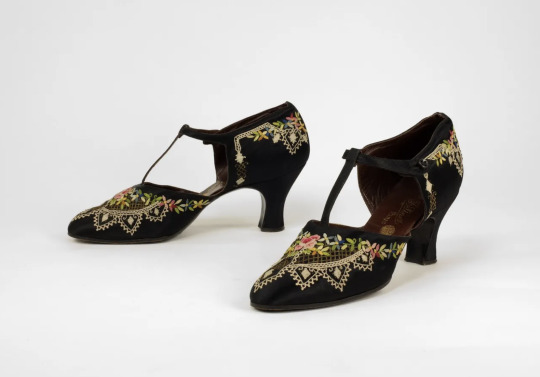
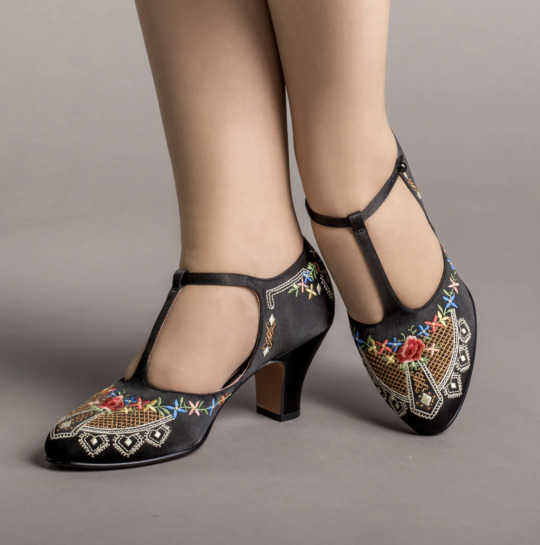
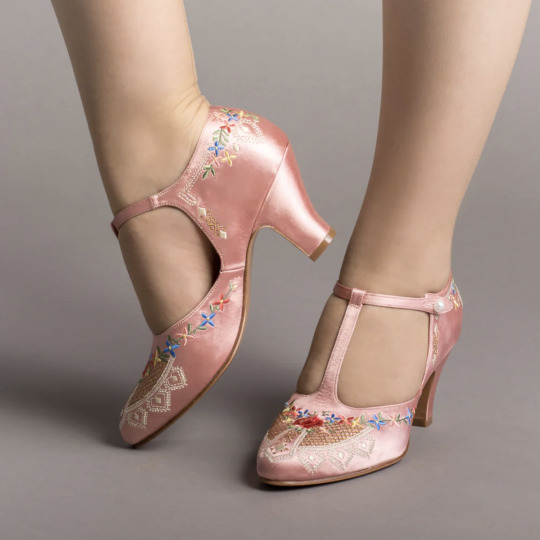
1920s shoes, Bata Shoe Museum / Daisy shoes, American Duchess.
The sales from the In Bloom collection will support The Bata Shoe Museum in their study, outreach, and conservation of historic footwear, and we're here for it.
More info:
"In Bloom: Flowers and Footwear"
Read more about the collaboration at the American Duchess Blog.
Buy the whole collection in pre-sale here.
Which style are you looking for the most?
#shoes#accessories#in bloom#florals#18th century#19th century#20th century#historical shoes#american duchess
8K notes
·
View notes
Text
Non-offensive Historical terms for Black people in historical fiction
@pleasespellchimerical asked:
So writing historical fiction, with a white POV character. I'm not sure how to address race in the narration. I do have a Black main character, and I feel like it'd feel out of place to have the narrator refer to her as 'Black', that being a more modern term. Not sure how to do this without dipping into common historical terms that are considered racist today. Thoughts on how to handle this delicately, not pull readers out of the narrative? (fwiw, the POV character has a lot of respect for the Black character. The narration should show this)
There are non-offensive terms you can use, even in historical fiction. We can absolutely refer to Black people without slurs, and if slurs is all one can come up with, it’s time to go back to the drawing board. I cannot say which terms are best for your piece without knowing the time period, but hopefully the list below helps.
Historical terms to use for Black people (non-offensive)
African American documented as early as 1782 (documented in an ad in the Pennsylvania Journal). Note the identity isn’t accurate for non-American Black people.
African could refer to African people or “from 1722 as ‘of or pertaining to black Americans.’”
The place of origin could also be used. For example, “a Nigerian woman”
Africo-American documented as early as 1788.
People of Color documented as early as 1796 (with specific contexts, usually mixed people)
Afro American documented as early as 1817, 1831 (depending on source)
Black American documented as early as 1831
Black was used in Old English to refer to dark-skinned people. Black was not capitalized until recent years, so “She was a young black woman.” would make sense to say, though “She was a young Black woman.” is the better standard today, although not universally adopted. I personally prefer it capitalized.
Moor was used as early as the late 1400s for North African people, but had a somewhat flexible use where anyone visibly Black / Of African descent or the Afro Diaspora might be referred to or assumed as a Moor. Note, it has other meanings too, such as referring to Muslim people, but that doesn’t mean the person using it is going by the dictionary definition. Not really the way to go today, but okay in a historical setting (in my opinion).
Biracial (1860s), mixed race (1872), multiracial (1903) and multicultural (1940s) are also terms to refer to people of two or more races.
Occupation + description. Throughout history, many people have been referred to as their occupation. For example, the Carpenter, The Baker, the Blacksmith. Here’s an example of how you might go about using occupation and traits to identify a Black character in history. Here’s an example I came up with on the fly.
“You should go by Jerry’s. He’s the best blacksmith this town’s ever seen. Ya know, the real tall, dark-skinned, curly haired fellow. Family’s come here from Liberia.”
Offensive and less-sensitive terms for Black people
Blacks was used in plural more, but this is generally offensive today (Even writing it gives me **Thee ick*)
Colored was mostly used post-civil war until the mid 20th century, when it became unacceptable. This is not to be conflated with the South African Coloured ethnic group.
Negro/Negroes were also used as early as the 1550s. Capitalization became common in the early 20th century. I'm sure you know it is offensive today, though, admittedly, was not generally seen as such until around the 1960s, when Black replaced it. It does have its contexts, such as the trope “The Magical Negro” but going around using the term or calling someone that today is a lot different.
Mulatto referred to mixed people, generally Black and white, and is offensive today.
The N-word, in all its forms, is explicitly a slur, and there is absolutely no need to use it, especially in a casual manner, in your story. We’ve written about handling the N-word and alluding to it “if need be” but there are other ways to show racism and tension without dropping the word willy-nilly.
Deciding what to use, a modern perspective
I’m in favor of authors relying on the less offensive, more acceptable terms. Particularly, authors outside of the race. Seldom use the offensive terms except from actual direct quotes.
You do not have to use those offensive terms or could at least avoid using them in excess. I know quite famous stories do, but that doesn’t mean we have to so eagerly go that route today. Honestly, from teachers to school, and fellow non-Black students, it’s the modern day glee that people seem to get when they “get a chance to say it” that makes it worse and also makes me not want to give people the chance.
It goes back to historical accuracy only counting the most for an “authentic experience” when it means being able to use offensive terms or exclude BIPOC from stories. We’ve got to ask ourselves why we want to plaster certain words everywhere for the sake of accuracy when there are other just as accurate, acceptable words to use that hurt less people.
Disclaimer: Opinions may vary on these matters. But just because someone from the group cosigns something by stating they’re not offended by it, doesn’t mean a whole lot of others are okay with it and their perspectives are now invalid! Also, of course, how one handles the use of these words as a Black person has a different connotation and freedom on how they use them.
~Mod Colette
The colonial context
Since no country was mentioned, I’m going to add a bit about the vocabulary surrounding Black people during slavery, especially in the Caribbean. Although, Colette adds, if your Black characters are slaves, this begs the question why we always gotta be slaves.
At the time, there were words used to describe people based on the percentage of Black blood they had. Those are words you may find during your searches but I advise you not to use them. As you will realize if you dive a bit into this system, it looks like a classifying table. At the time, people were trying to lighten their descent and those words were used for some as a sort of rank. Louisiana being French for a time, those expressions were also seen there until the end of the 19th century.
The fractions I use were the number of Black ancestors someone had to have to be called accordingly.
Short-list here :
½ : mûlatre or mulatto
¼ or ⅛ : quarteron or métis (depending on the island, I’m thinking about Saint-Domingue, Martinique and Guadeloupe)
1/16 : mamelouk
¾ : griffe or capre
⅞ : sacatra
In Saint-Domingue, it could go down to 1/64, where people were considered sang-mêlé (mixed blood for literal translation, but “HP and the Half-Blood Prince” is translated “HP et le Prince de Sang-Mêlé” in French, so I guess this is another translation possibility).
-Lydie
Use the 3rd person narrative to your advantage
If you are intent on illustrating historical changes in terminology consider something as simple as showing the contrast between using “black” for first person character narration, but “Black” for 3rd person narrator omniscient.
-Marika
Add a disclaimer
I liked how this was addressed in the new American Girl books
it’s set in Harlem in the 1920’s and there’s a paragraph at the beginning that says “this book uses the common language of the time period and it’s not appropriate to use now”
-SK
More reading:
NYT: Use of ‘African-American’ Dates to Nation’s Early Days
The Etymology dictionary - great resource for historical fiction
Wikipedia: Person of Color
2K notes
·
View notes
Text

[ID: A group of pastry pinwheels on a blue plate next to a bowl of yoghurt garnished with parsley. End ID]
صفيحة يافاوية / Safiha yafawiyya (Yaffan pinwheels)
The dish
صَفِيحَة يَافَاوِيَّة ("ṣafīḥa yāfāwīyya") is a type of safiha, or flatbread, believed to have originated in the coastal city of يافا (yāfā; "Yaffa," sometimes "Jaffa"). While other versions of safiha consist of a flat piece of dough topped with meat, Yaffan safiha are made by rolling dough out to a transparent thinness, folding it to enclose a filling of meat or spinach, and then whirling it around into a pinwheel shape. More highly valued in Yaffa than flat safiha, Yaffan safiha inspires proprietary feelings amongst residents and emigrants. The technique has, however, spread to other areas in Palestine, as well as to Alexandria, Egypt, where a large number of Yaffan exiles have resettled.
Yaffan safiha may also be called "حواية" ("ḥawāya"), after a kind of towel that is stitched into a spiral and placed on top of the head to cushion it while carrying jugs of water, or trays that are hot from the oven. One Yaffan woman remembers her mother assembling these pastries at home and then bringing them, in a large copper tray, to the baker, so they could be cooked in a shared oven for a small fee. The baker's wife would have to wait to use the oven another day. The usage of communal ovens by those who do not have an oven in their home is still common practice in rural areas of Palestine.
Traditionally, the dough used to make Yaffan safiha includes only flour, salt, oil, and water. Some modern Palestinian recipes leaven the dough with baking powder; or include milk powder as a way to use food aid from NGOs, which seek to alleviate the effects of the Israeli occupation's extreme restriction of transport, travel, and agricultural activities on Palestinians' diets. With a spinach filling and without milk powder, the safa'ih may be described as "صيامي" ("ṣiyāmī): a word derived from "صِيَام" ("ṣiyām"; "fast") but which, due to the abstention from meat mandated during the Lenten fast, is colloquially used to mean "vegetarian."
Golden brown and fragrant with olive oil, these safa'ih combine layers of crisp, flaky dough with a savory, well-spiced filling. Recipes for both a 'meat' and a spinach filling are provided. A side of yoghurt and a garnish of mint round out the flavors of the filling and add tanginess and textural contrast.

[ID: Close-up of two pinwheels cut open to reveal a spinach filling and a 'meat' filling between thin layers of pastry. End ID]
The Bride of Palestine
Yaffa is a port city with an ancient history which, until the 20th century, was the largest Arab city in, and the cultural and economic capital of, Palestine. For this reason it has sometimes been called عروس" "فلسطين ("'arūs filasṭīn"); "The Bride of Palestine." With the 1909 founding of the nearby Tel Aviv, Yaffa began to be considered its "twin" or "sister" ("האחיות") city; it had a distinctly Arab character where Tel Aviv was almost entirely Jewish. Yaffa was thus considered in disctinctly racialized terms: both attraction and threat; a source of authentic rootedness in the land which could be tapped, but also a potentially contagious bastion of Oriental "weak[ness]" ("חליש").
Yaffa had been a popular destination for culinary tourism in Mandate Palestine, with young settlers heading to the seaside to escape from religious studies and religious dietary restrictions—associated with diaspora Judaism and a lack of connection to a homeland—and to eat earthier Arab foods such as hummus, falafel, kebab, and ful.
In 1948, Zionist paramilitary organization Irgun dropped several tons of British bombs on major civilian areas of Yaffa in order to overwhelm resistance and empty the city of its Arab population; they destroyed the much of the Old City in the process. The neighborhood of المنشية (Manshiya) was destroyed shortly thereafter. Beginning in December of 1948, Yaffa was, part by part, annexed to Tel Aviv.
Today, despite the annexation and the Hebraization of the street signs, Yaffa maintains an Arab character in popular discourse. The call to prayer is heard in the streets, and the أبو العافي (Abulafia) bakery and أبو حسن (Abu Hassan) hummus restaurant and remain where they have been since the 1760s and 1970s, respectively. But increasing gentrification, rising rent prices, cafes and restaurants which cater to tourists and settlers, and the construction of Jewish-only residential projects threaten to continue the ethnic cleansing of the ancient city.
Yaffan Cuisine
Israeli occupation has tended to collapse some of the regional distinctions within Palestinian cuisine, as Palestinians are forced into exile or else crowded into Gaza and into smaller and smaller enclaves within the West Bank. Some dishes, however, still have variations that are associated with particular cities. Stuffed red carrots (محشي الجزر الأحمر; "maḥshi al-jazar al-'aḥmar"), cored and filled with rice and spiced meat, are a dish common throughout Palestine but cooked differently everywhere: in a sauce of lemon juice, pomegranate molasses, and red tahina in Gaza; in tamarind paste in Al-Quds and Ramallah; and in orange juice in the orange-rich Yaffa region. Abu Hassan restaurant serves مسبحة (msabbaha), a Yaffan classic in which chickpeas and tahina are mixed with green chili pepper, and lemon juice.
Donate to an evacuation fund
Buy an eSim for use in Gaza
Help Anera provide food in Gaza
Ingredients:
For the dough (makes 32):
500g flour (4 cups + 1 Tbsp)
1 tsp table salt
2 Tbsp olive oil
Enough water to form a soft, tacky dough (about 1 3/4 cup / 500mL)
For the meat filling (makes 16):
125g vegetarian ground beef (as a substitute for minced lamb)
1 small yellow onion, minced
1 Tbsp olive oil
1/2 tsp ground allspice
1/2 tsp ground black pepper
1/2 tsp ground cardamom
1/2 tsp table salt, or to taste
1/2 Tbsp ground sumac
1/2 Tbsp pomegranate molasses (optional)
For the spinach filling (makes 16):
500g spinach, washed and chopped
1 tsp kosher salt, for removing water
1 small yellow onion, minced
1 Tbsp olive oil
1/4 tsp ground black pepper
1/4 tsp table salt, or to taste
Squeeze of lemon juice
1 tsp shatta (hot red pepper paste)
1/2 Tbsp pomegranate molasses (optional)
Some recipes include sumac in the spinach filling, but this is not considered traditional.
Instructions:
For the dough:
1. Measure dry ingredients into a large mixing bowl. Add oil and mix briefly. Add water, a little at a time, until the dough comes together into a slightly tacky ball. Knead for five minutes, until smooth and elastic.
2. Divide dough into 16 balls of about 50g each. Roll it out into a cylinder and cut it in half repeatedly; or weigh the dough using a kitchen scale and divide by 16.
3. Pour some olive oil in a tray or baking sheet and coat each dough ball. Leave them on the tray, covered, to rest while you prepare the fillings.

For the meat filling:
1. Heat 1 Tbsp olive oil on medium-high. Add meat and fry, stirring often, until nearly cooked through.
2. Add onions, salt, and spices and fry until onion is translucent.
3. Remove from heat. Stir in sumac and pomegranate molasses. Taste and adjust. Let cool.
For the spinach filling:
1. Mix spinach with salt and let sit 10-15 minutes. Squeeze to remove excess water.
2. Heat 1 Tbsp olive oil in medium-high. Fry onion, salt, and pepper for a minute until translucent.
3. Combine all ingredients. Taste and adjust salt.
To assemble:
1. Oil a clean work surface, as well as your hands. Spread a dough ball out into a very thin, translucent circle by repeatedly patting with your fingers while pushing outwards. Be sure to push outwards from the center so that the circle does not become too thin at the edges. A few small holes are okay, since the dough will be folded and rolled in on itself.

2. Cut the circle in half with a sharp knife. Spread 1/16 of either filling in a thin line along the cut edge, leaving a margin of 1 cm (1/2") or so.

3. Roll the edge of the dough (the cut edge) over to encase the filling. Continue rolling, trying as much as possible to exclude air, until you have a long rope of dough.


4. Roll the rope around in a tight spiral. Tuck the very end of the dough underneath and press to seal. Place on a preparing baking sheet.

5. Repeat until the filling and dough are used up. Meanwhile, preheat an oven to 375 °F (190 °C). Bake the safiha in the top third of the oven for 25-30 minutes, or until golden in color.
Serve warm with yoghurt.
565 notes
·
View notes
Text
On Boxing Day pro-Palestine demonstrators met customers at the Zara sale in the Westfield shopping centre, in Stratford, east London. They were not there to wish them the compliments of the season.
‘Bombs are dropping while you’re shopping,’ they chanted, as police stood by to make sure the protests did not turn violent. ‘Zara is enabling genocide,’ their placards read.
Quite what they wanted bargain hunters to do about the Israeli forces bombing the Gaza Strip, they never said. Lobby their MPs? Politicians are on their Christmas holidays. Join the Palestinian armed struggle? It was unclear whether the shopping centre had a Hamas recruitment office.
But on one point the demonstrators were certain: no one should be buying from Zara. Even though the fashion chain has not encouraged Israel’s war against Hamas, earned income from it, or supported Israel in any material way, it was nevertheless “exploiting a genocide and commodifying Palestine's pain for profit”.
Zara, in short, has become the object of a paranoid fantasy: a QAnon conspiracy theory for the postcolonial left.
The Zara conspiracy is an entirely modern phenomenon. It has no original author. Antisemitic Russians sat down and wrote the Protocols of the Elders of Zion in the early 20th century. There was an actual “Q” behind the QAnon conspiracy: a far-right activist who first appeared on 4chan message boards in 2017 to claim that a cabal of child abusers was conspiring against Donald Trump.
The Zara conspiracy was mass produced by social media users: an example of the madness of crowds rather than their supposed wisdom. The cause of the descent into hysteria was bizarre.
In early December Zara launched an advertising campaign featuring the model Kristen McMenamy wearing its latest collection in a sculptor’s studio. It clearly was a studio, by the way, and not a war zone in southern Israel or Gaza. McMenamy carried a mannequin wrapped in white fabric. The cry went up that the Spanish company was exploiting the suffering of Palestinians and that the mannequin was meant to represent a victim of Israeli aggression wrapped in a shroud.
The accusation was insane. No one in the photo shoot resembled a soldier or a casualty of war. Anyone who thought for 30 seconds before resorting to social media would have known that global brands plan their advertising campaigns months in advance.
Zara said the campaign presented “a series of images of unfinished sculptures in a sculptor’s studio and was created with the sole purpose of showcasing craft-made garments in an artistic context”. The idea for the studio setting was conceived in July. The photo shoot was in September, weeks before the Hamas assault on Israel on 7 October.
No one cared. Melanie Elturk, the CEO of fashion brand Haute Hijab, said of the campaign, ‘this is sick. What kind of sick, twisted, and sadistic images am I looking at?’ #BoycottZara trended on Twitter, as users said that Zara was ‘utterly shameful and disgraceful”’.
To justify their condemnations, activists developed ever-weirder theories. A piece of cardboard in the photoshoot was meant to be a map of Israel/Palestine turned upside down. Because a Zara executive had once invited an extreme right-wing Israeli politician to a meeting, the whole company was damned.
Astonishingly, or maybe not so astonishingly to anyone who follows online manias, the fake accusations worked. Zara stores in Glasgow, Toronto. Hanover, Melbourne and Amsterdam were targeted.
What on earth could Zara do? PR specialists normally say that the worst type of apology is the non-apology apology, when a public figure or institution shows no remorse, but instead says that they are sorry that people are offended. Yet Zara had not sought to trivialize or profit from the war so what else could it do but offer a non-apology apology? The company duly said it was sorry that people were upset.
“Unfortunately, some customers felt offended by these images, which have now been removed, and saw in them something far from what was intended when they were created,” it said on 13 December, and pulled the advertising campaign
That was two-weeks ago and yet still the protests in Zara stores continue. On 23 December activists targeted Zara on Oxford Street chanting , 'Zara, Zara, you can't hide, stop supporting genocide', even though Zara was not, in fact, supporting genocide. On Boxing Day, they were at the Stratford shopping centre.
Zara has apologised for an offence it did not commit. There is no way that any serious person can believe the charges against it. And yet believe them the protestors do. Or at the very least they pretend to believe for the sake of keeping in with their allies.
Maybe nothing will come of the protests. One could have argued in 2017, after all, that QAnon was essentially simple-minded people living out their fantasies online. Certainly, every sane American knew that there was no clique of paedophiles running the Democrat party, but where was the harm in the conspiracy theory?
Then QAnon supporters stormed the US capitol in January 2021. Will the same story play out from the Gaza protests? As far as I can tell, no one on the left is challenging the paranoia. I have yet to see the fact-checkers of the BBC and Channel 4 warning about the fake news on the left with anything like the gusto with which they treat its counterparts on the right.
To be fair, the scale of disinformation around the Gaza war is off the charts, and it is impossible to chase down every lie. But when fake news goes from online fantasies to real world protests, from 4chan to the Capitol, from Twitter to the Westfield shopping centre, it’s worth taking notice.
Sensible supporters of a Palestinian state ought to be the most concerned. No one apart from fascists, Islamists and far leftists believes that Israel should not defend itself. And yet the scale of its military action in Gaza is outraging world opinion. Mainstream politicians, who might one day put pressure on Israel, remain very wary about reflecting the anger on the streets.
They look at the insane conspiracy theories on the western left and see them as no different from the insane conspiracy theories that motivate Hamas, and they back away.
The Palestinians need many things: an end to the Netanyahu government, and an end to Hamas. But they could also use allies in the West who do not discredit their cause with dark, gibbering fantasies.
503 notes
·
View notes
Text
The Poll
So, for those who don’t know, I put up a poll of, “Who was the worst American President?” The list was FDR, Woodrow Wilson, Lyndon Johnson, Herbert Hoover, and Richard Nixon. It got up to about 13k notes before I deleted it, because I was tired of the notes clogging up my feed. And the results were... telling.
About 75-80% of all the notes were, “Where is Reagan/Andrew Jackson?!?” Many of the rest, though, can be seen below:
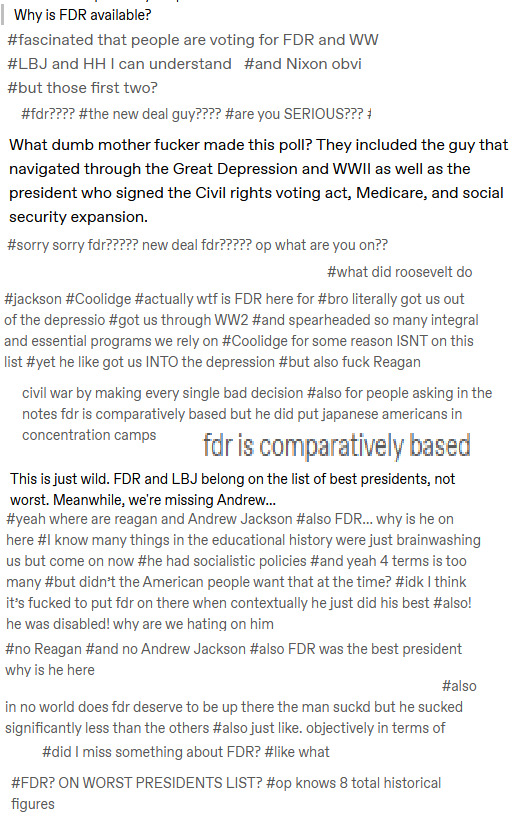
What this tells me is that more than ten thousand people didn’t have an education; they had an indoctrination.

You want to hear it? All right, buckle up, because it’s time for a stroll down memory lane.
Why was FDR a bad president?
It is almost hard to know where to begin with this. Let’s start with one of the most basic ones: The belief that FDR got us out of the Depression.
Point of fact, No the fuck he did not.
Making American Depressed
If you ask almost any historian or economist, they will tell you flat-out that not only did the New Deal not end the Great Depression, but that it made it significantly longer and worse than it would have been otherwise. Hoover bears some of the blame for this, but the pseudo-socialist dogshit that was the New Deal bears the brunt of the blame for this one.
The stock market crashed in late October, 1929. Two months later, unemployment peaked at 9%. Over the next several months, unemployment started to fall, down to 5-6% by the spring of the next year. Half a year after the crash, unemployment had not hit double digits. Hoover’s intervention, though, did cause unemployment to reach double digits. Roosevelt was elected in 1932 and took office in 1933, and unemployment did not fall out of double digits for the remainder of the 1930′s. The thing that actually pulled the US out of the Depression was the second World War; turns out that removing roughly 12 million people from the labor force to go and fight does wonders for unemployment numbers. FDR even said that Doctor New Deal was replaced by Doctor Win-The-War.
This was hardly the first economic downturn in American history. For the first 150 years of this country, there were downturns all the time. And what the government did was nothing, and the economy recovered on its own. But Roosevelt represents the first massive large-scale intervention in the economy. And government intervention in the economy slows economic recovery; when you have no idea what the government is going to do tomorrow in regards to the economy, it’s hard to make smart financial decisions, so you just don’t bother. After all, why do anything if tomorrow, the rules of the game are going to change?
Separation of Powers Who?
FDR issued more executive orders than any other President of the 20th century. He may, in fact, have issued more than all the other Presidents of the 20th century combined. Rather than letting Congress, the legislative branch of government, you know, legislate, he preferred to try to do everything himself.
The President is supposed to be the weakest branch of the government, but Roosevelt did everything he could to try to establish its supremacy over the other branches. When Congress didn’t give him his way, he used executive orders. When the Supreme Court challenged some of his acts as unconstitutional, his response was to threaten to have them replaced, or to simply pack the court with judges more sympathetic to his aims. This is a man who was openly contemptuous of the concept of the rule of law.
Here’s a fun entry from the notes:

Hey, you want to talk about fascists? Actual, honest-to-goodness Fascists, not just the modern definition (i.e. anyone a nanometer to the right of Noam Chomsky)? Let’s talk about the originals. Let’s talk about the inventor of Fascism, Benito motherfucking Mussolini. And how FDR openly admired him, and was “deeply impressed by what he has accomplished”, calling Fascism the “cleanest, most efficiently operating piece of social machinery [he had] ever seen”, and that it made him “envious”. And Mussolini, for his part, said of Roosevelt that, “Reminiscent of Fascism is the principle that the state no longer leaves the economy to its own devices … Without question, the mood accompanying this sea change resembles that of Fascism.”
When the guy who fucking invented Fascism is saying that he thinks that you are also doing Fascism, then maybe you’re not a good person.
Concentration- I Mean, Internment Camps
And just like his buddies on the other side of the Atlantic, right when World War 2 kicked off, Roosevelt thought it would be a good idea to take “undesirables” and throw them into prison camps. Roughly 20 thousand Italian- and German-Americans, American citizens, were thrown into camps, simply for the crime of having ancestors from countries we were at war with. And then, of course, there’s the 120 thousand Japanese-Americans who were likewise rounded up and put into prison camps, two thirds of whom were natural-born American citizens.
Almost 150 thousand American citizens, thrown into literal concentration camps, without the bother and expense of due process, stripped of their constitutional rights simply on the basis of race.
As for the concentration camps set up in Europe by the Nazis, however? Despite being told of their existence by people who had escaped, as well as journalists and lawyers from Germany, once American planes gained the ability to attack those camps, to shut them down? FDR refused to grant them permission to do so.
Commander in Thief
Executive Order 6102 outlawed the private ownership of gold, allowing the government to confiscate all of it. Once that was accomplished, the Gold Reserve Act allowed him to change the value of gold, debasing America’s currency (which was on a gold standard at the time), which permitted him to steal literally billions of dollars from American citizens, without any compensation.
World War, Too
There is evidence to suggest that Roosevelt knew about the imminent attack on America by Japan in December of 1941. He discussed with several high-ranking people in the War Department, and in his own cabinet, how to get Japan to fire the first shot in the war, so that he could get America involved. It would make sense: His oil embargo was designed to provoke a Japanese response, so as to draw America into the war. And once America was in the war, ordered the Philippines to be abandoned, outright lying that there was an army waiting to retake it once it had been conquered by Japan.
And as the war dragged on, he got quite cozy with Uncle Joe, Stalin himself. He helped to repatriate two million people to Russia, who very much did not want to go back, many of them ending up either in the gulags, or simply killed outright. And his constant concessions to Stalin helped the Soviet Union hold on to eastern Europe, setting the stage for the Cold War. Even when he was informed of Soviet spies within the American government, and provided evidence of their disloyalty and subversion, he simply let them keep at it.
Racism, Racism, and more Racism
Remember how you cheered when lynching was made a federal crime a few months ago, and asked why it hadn’t been done before now? Well, the main reason was good ol’ FDR himself. A bill was proposed in the Congress which would have made lynching a federal crime, and Roosevelt refused to pass it.
Or what about during the Olympic games in Berlin, when black athletes from America took home multiple gold medals? Roosevelt invited the white athletes to the White House, but not a single black one. Jesse Owens, who won four gold medals, said, “Hitler didn’t snub me --- it was [Roosevelt] who snubbed me. The president didn’t even send me a telegram.”
And then there was his nomination of a KKK member to the Supreme Court; Hugo Black, who had zero judicial experience, was nominated simply because he supported the New Deal.
He also was of the opinion that America was, and ought to remain, a white and Protestant country, and that too many Jews was inherently a bad thing, because of how distasteful he found them. He boasted that there was no Jewish blood in his veins, as a mark of pride. He even went so far as to turn away ships of Jewish refugees, fleeing Nazi tyranny in Europe.
In conclusion
FDR was a massive piece of shit. He massively overstepped his constitutionally-appointed bounds at every available opportunity, massively expanding the power of the Presidency at the expense of all other parts of government, and at the expense of individual liberty. He was openly racist and anti-Semitic. His economic policies brought ruin upon the American economy. He openly praised fascism right up until the moment that it was no longer politically expedient to do so, and switched to deferring to authoritarian communism instead. Almost everything that you hate about the modern United States can be traced directly back to this one man.
The fact that he is remembered as not just a good President, but one of the best Presidents, shows how utterly broken American education is.

1K notes
·
View notes
Text
Little Art things I'm obsessed with pt 1
Portraits of absent figures:

David Hockney - A Bigger Splash, 1967
Hockney originally visited California in 1963 and was won over by the sunlight and laid-back lifestyle, especially the luxury and ubiquity of the swimming pool. He described it as his "promised land"
The splash is about freezing a moment in time, but it is also empty of human presence but implying a human.
The male figure is present in some of David's other works from this time period, especially his muse and then-partner Peter Schlesinger. These paintings are about a hedonistic gay lifestyle, and the swimmers, the divers, are often the subject of voyeurism and desire. But in this painting, we just missed the diver, which makes the object of desire more private and personal. Who was the painter looking at, lusting after, etc.
I like the contrast of the incredibly sharp and graphic suburban neighborhood, and the chaotic, organic splash. So again, if the divers represent this homosexual desire, we have this contrast of an orderly heterosexual world, and the queerness that joyfully disrupts it.
And then of course, with the absent figure, there is this massive sense of loss and loneliness. And so much of loneliness is about concealment, hiding in shame. This is a private space, but its also an exposed space, enhancing the loneliness. The figure is isolated, alone, invisible. Its a sadness that contrasts with the setting, the activity, and saturated lighting.

Felix Gonzalez-Torres - Untitled (billboard of an empty bed), 1991
These billboards were exhibited in the streets of Manhattan during the AIDS crisis. This piece was created the same year Felix Gonzalez-Torres's boyfriend Ross died. This portrait is a celebration of love and a memorization of loss and the emotions between intimacy and publicity. In the artist's own words:
“What I’m trying to say is that we cannot give the powers that be what they want, what they are expecting from us. Some homophobic senator is going to have a very hard time trying to explain to his constituency that my work is homoerotic or pornographic, but if I were to do a performance with HIV blood — that’s what he wants, that’s what the rags expect because they can sensationalize that, and that’s what’s disappointing. Some of the work I make is more effective because it’s more dangerous. We both make work that looks like something else but it’s not that. We’re infiltrating that look.“
The work intentionally uses the matching, identical depressions to imply a same-sex couple. The image itself is extremely intimate, but its being displayed in public spaces.
Felix Gonzales-Torres became known for his absent bodies.
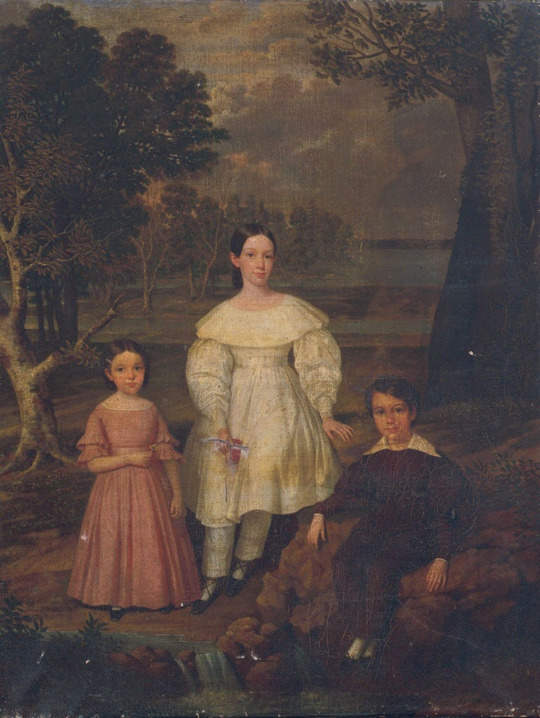
And then, a little different, this painting by Jacques Guillaume Lucien Amans (1837) commissioned by Frederick and and Coralie Frey, depicts the three Frey children, with the faint shadow of a figure. There was a legend that there was a fourth figure in this painting. In 2005 a private collector, Jeremy K Simien, purchased the painting and it underwent conservation.
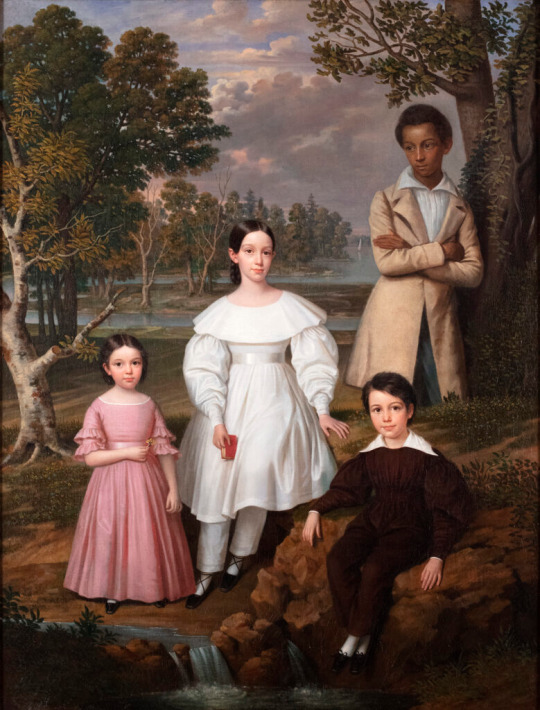
The painting revealed Bélizaire, a fifteen year-old enslaved domestic owned by the children's father. The picture captures the complex relationship between the boy and the children, the family that was keeping him captive. For one thing, the way he is set back from the others. There is this sort of intimacy between them along side the psychological trauma of forced bondage.
Here is a great Tiktok about the painting, to quote "What I'm struck by is what a sensitive portrait this is of this young man who was living in an inhumane society where he, despite being a human being, was bought and sold."
A few years after this painting was created, the three Frey children died, and Bélizaire was the only one who survived into adulthood.
The painting stayed in the Frey family. At some point, likely in the late 19th or 20th century, Bélizaire was intentionally painted over. In 1972, the great-granddaughter of Coralie Frey donated the painting to a Louisiana museum, informing them that a figure was painted over. During the course of the painting's life at the museum, no effort was put into restoring the figure.
Jeremy Simien's, who bought and restored this painting, said on his instagram "Bélizaire, they know your name now. Tell the ancestors to let me sleep for a minute."
And shout out to the picture that make me want to write this, Hyde Park Flowers, London by Tumblr user @kimironside I won't re-post it so check out the link.
#art#art history#felix gonzalez torres#belizaire#david hockney#Jacques Guillaume Lucien Amans#Jacques Amans#Jeremy K Simien#tw slavery#tw aids
1K notes
·
View notes
Text
PORSCHE F1 TEAM

Precision Performance, Driven by Innovation
The roots of this prestigious car company date back to the early 20th century, when Ferdinand Porsche created the renowned company for automobiles in 1931. With a plentiful background of enginery exploration and innovation, Porsche has always willed itself to be associated with perfection, performance and precision. In the upcoming 2025 season of Formula One, Porsche has entered the race with a bold vision set to redefine the standard of excellence on the track. With cutting-edge technology, talent of the stars to the pursuit of vigilance, Porsche F1 Teams aim to re-write the triumph and legacy of Formula 1 history.
Sponsors :
Porsche boasts many sponsors on a universal scale, but notable names include:
‐ Hugo Boss ━ Plays a large part in designing the team's racing apparel and merch.
‐ Bose ━ Leading audio equipment manufacturer, could not only provide brand apparel but also help enhance team communication
‐ Adidas ━ For merchandising and casual team sports wear
‐ Rolex ━ A key sponsor that provides gold members with limited edition pieces created for/by the team
‐ Shell [shared with legacy team, Ferrari] ━ Provides fuel and lubricants for the team.
‐ Emirates ━ Major airline, provides commercial air trips for the team members and manufactures private jet's for important participants [drivers, team principal, CEO etc.]
‐ Sabyasachi ━ Provides sponsorship and media advertising
‐ Mahindra ━ Partnered with Porsche design and engine customisation
‐ Royal Enfield ━ Brand deals and apparel in India
‐ Amrapali jewels ━ sponsorship support along with more exclusive pieces for the team
‐ Forest essentials ━ An Indian focussed skincare brand, appealing to the more casual viewers of the sport along with media and sponsorship duties.
Team principal :
Katherine "Kate" Anderson
Katherine Anderson, also known as Kate originated from Manchester, United Kingdom. Growing up in a motorsport passionate family dynamic, her passion was sparked early on as she decided to pursue automobile and engine engineering from Oxford University. Her continued studies in Business and Advertising allowed her to pioneer women in motorsport events and lead to her being picked for the prestigious Porsche F1 team, being entrusted to bring the brand to success.
Kate is known for her dynamic leadership persona and innovative approach to management in general. She empowers her employees and colleagues under her command and fosters a friendly environment, creating excelling team performance on and off the track.
She is known to be a friendly face around the paddock, creating humorous situations and playing pranks on other personal around her. She is a natural-borne leader and commands to power and tenacity in pursuit for perfection, positive change and is a personality for inspiration to all female driver generations all around.
Drivers :
1 . Aisha Patel. 🪷
2 . Pierre Gasly. 🥐
honourary tags [for special pookies] : @disneyprincemuke, @weekendlusting, @woozarts, @mellowarcadefun, @paintedbypoetry, @33-81, @kazuha-pista-badam
#[darlingisnowadmin]#f1#f1 blurb#f1 drabble#f1 fandom#f1 fanfic#f1 fanfiction#f1 fic#f1 series#masterlist#series#new! series#f1 masterlist#f1 imagine#f1 x reader#Max Verstappen#Max Verstappen imagine#f1 fluff#f1 smut#f1 x female reader#Max Verstappen fanfic#Max Verstappen fluff#f1blr#[darlingwrites]#Spotify#charles leclerc fic#charles leclerc fanfic#charles leclerc x reader#charles leclerc#charles leclerc imagine
141 notes
·
View notes
Text
iwtv casting department: let's have auditions with people from all over the world, so we can cast the best actors regardless of where they're from.
iwtv writers: let's use the inconsistencies and contradictions of the original text to tell a story about the malleability of memory. Let's keep the beautiful language of the original text but move the story to a different time period. Let's not hide from the themes of race and sexuality.
iwtv costume department: let's make elaborate pieces that reflect the characters identities. Also, lets make suits that fit the protagonists like a glove, and patterned leather shoes (even if they're barely visible).
iwtv set design department: let's make a super detailed, super accurate recreation of New Orleans at the beginning of the 20th century. Even the lightbulbs have to be accurate.
iwtv actors: let's pour our body and soul into this characters. Let's be sure we know their stories and motivations inside and out.
amc marketing department: let's have a shered social media presence for both interview with the vampire and the mayfair witches. This way we can bury iwtv's podcast under the mw's podcast. Also, let's make an instagram post celebrating alexandra daddario's birthday, but not one for sam reid.
#i could also have talk about the sound desing and the directorial choices#but you get the point#if i worked in iwtv i'd be so pissed#interview with the vampire#amc iwtv#iwtv#this is not an anti mw post this is an anti marketing department post
641 notes
·
View notes
Text
SPY x FAMILY x CHAIR Vol. 7~8~9
SxF Vol 7 · Damian Desmond - Willow Chair
The Willow Chair was designed by Scottish architect Charles Rennie Mackintosh in the early 20th century. The chair was originally designed for use in The Willow Tea Rooms Company, a cafe and tea room that Mackintosh also designed in Glasgow, Scotland. The chair was part of a larger collection of furniture pieces designed for this company.
The concept of tea rooms was popular in Victorian and Edwardian times, and was considered a meeting place for the upper middle class.

The design shows a progressive approach to design, suggesting that the chair is at the forefront of creative thinking and is sleek, modern and curious. It stands out for its simplicity in geometric patterns. The chair features straight, minimalist lines in its structure, with curved wooden elements at the top to provide head and neck support.
A distinctive feature is its triangular backrest, which extends upward from the arms at an acute angle to create a sleek and elegant silhouette. The seat also features an elaborate lattice pattern, made from hand-woven wicker, which adds texture and dimension to the chair.
I’m Damian, scion of the Desmond family! I’ll be a politician one day and protect this country!
I love the way the dimension of the chair in disproportionate to Damian's body, who is clearly a kid with a very big precedent behind him, a very big ego and pride in possessing the last name Desmond, and it projects very well the way it makes Damian look more imposing for his age while giving you a look that continually judges you, adorably.
Damian is someone who projects himself from greatness, and his constant yearnings to be a recognized figure such as his family, even so, his childlike soul continues to exist.
However deep down, behind all the Desmond pride (Reflected in the chair) are his yearnings to really have fun and enjoy his childhood wanting to play with his balls, read manga, play with dinosaurs. He is definitely a little boy with a lot behind his shoulders.
SxF Vol 8 · Franky Franklyn - Eames Lounge chair & Ottoman
The Eames Lounge Chair and Ottoman were designed by Charles and Ray Eames in 1956, an American designer couple.
It was created from the idea of a "comfortable as a glove" chair, with an ergonomically molded seat and back shell combined with a plywood base. It was originally designed for the Herman Miller furniture company.

It was designed to provide comfort and relaxation, elegant and attractive that will complement any living space. The chair features clean, simple lines and a minimalist structure that emphasizes its elegance and ergonomics. The base is made of plywood, bent in several layers and smoothly polished to give it a smooth, refined finish.
Can we talk about how relaxed and cool Ostania's best informant looks? I love how the combination of this chair reflects Franky's relaxed but refined personality, a genius at his job even if often not properly appreciated. However, we can see his details, a bit messy, his taste for money, some good cigars, some confidential envelopes.
It's interesting when you remember that Franky seems to hate the handsome, moneyed show-offs who seem to be very lucky, even though he wishes he was one. He is simple and laid back, with a classy side and a profitable bottom line.
SxF Vol 9 · Becky Blackbell - Coconut Chair
The Coconut chair was designed by architect and designer George Nelson in 1955 who was the design director for Herman Miller.
The chair was inspired by the designer's tropical landscape during his visit to the Fiji Islands. Nelson observed a group of children playing with one half of a coconut shell and realized that the shape and curve of the coconut shell could be harnessed to design a comfortable, modern chair. It was created as a highly engineered piece of furniture that offered a high level of comfort.

Although originally designed as a lounge chair, the Coconut chair is suitable for any space, from offices to homes. The stainless steel tripod base is an attractive design element, its fine details such as the apparent stitching on the upholstered
"You and I should be best friends"
I like how both the Coconut chair and Becky could be described as elegant, sophisticated, avant-garde and with a lot of personality. Despite her young age, we know that Becky has a very definite personality, sometimes with a very volatile and fanciful imagination.
Unlike many Spy x Family characters and their respective chairs, the elements are usually placed at the back or bottom with respect to the chair, always covered by some slight shadow, reflecting those elements that characterize the respective personality.
However, all of Becky's things are clearly displayed and stacked with bright colors. We know that it refers to all the riches and luxuries Becky has, as well as her passion for fashion and shopping.
But also, it's a way of expressing how authentic Becky is and how she's not afraid to show her true personality without having to hide it.
You can read the previous review here!
You can read the next part here
#spy x familyxchair#spy x family#spy x family manga 71#twiyor#loid forger#yor forger#loid x yor#yor briar#twilight#anya forger#spyxfamily twilight#sxf#becky blackbell#franky franklin#damian desmond
228 notes
·
View notes